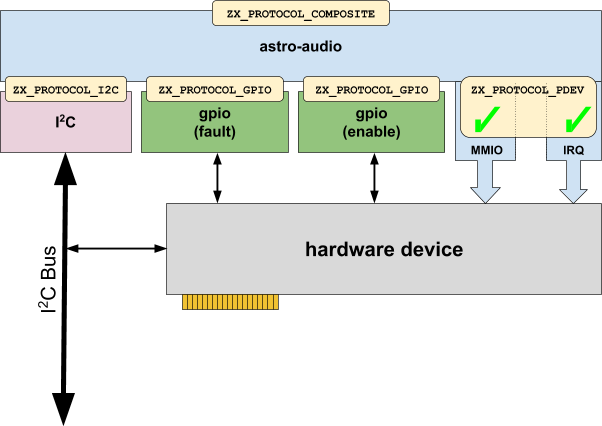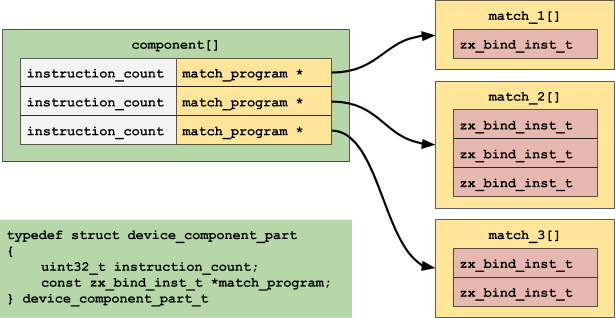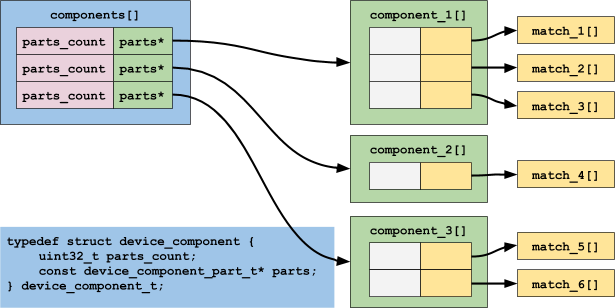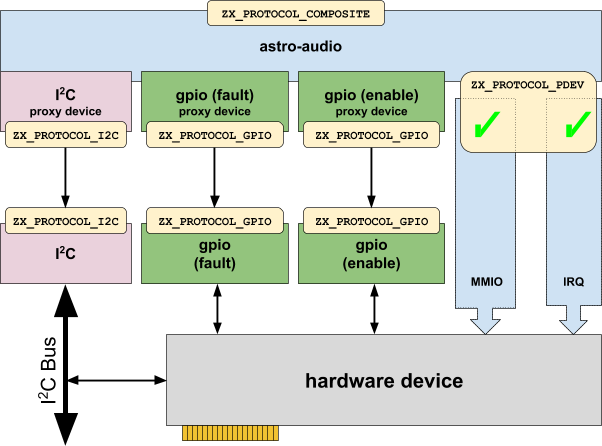Introduction
In this section, we look at composite devices. A composite device is a device composed of other devices.
These devices address the case of hardware-level composition, in which a "device" (from the user's perspective) is implemented by several distinct hardware blocks.
Examples include:
- a touch panel composed of an I2C device and a GPIO,
- an ethernet device composed of a MAC chip and one or more PHYs, or
- an audio device composed of an audio controller and a set of codecs.
In these situations, the relationship of the hardware is known to the board driver at boot time (either statically or through a dynamic means, such as ACPI).
We'll use the astro-audio device for our examples:

This device features:
- an I2C bus interface
- two sets of GPIOs (one for fault, one for enable)
- MMIO (memory mapped I/O) for bulk data transfer, and
- an IRQ (interrupt request) line to generate interrupts to the driver.
Note that the ZX_PROTOCOL_I2C and ZX_PROTOCOL_GPIO protocols are used to
transfer data; that is, I2C messages, and GPIO pin status are sent and received
through the respective drivers.
The ZX_PROTOCOL_PDEV part is different.
Here, the protocol is used only to grant access (the green checkmarks in the
diagram) to the MMIO and IRQ; the actual MMIO data and interrupts are not
handled by the PDEV; they're handled directly by the astro-audio driver
itself.
Creating a composite device
To create a composite device, a number of data structures need to be set up.
Binding instructions
We need a number of binding instructions (zx_bind_inst_t) that tell us which
devices we match.
For the astro-audio device, we have:
static const zx_bind_inst_t i2c_match[] = {
BI_ABORT_IF(NE, BIND_PROTOCOL, ZX_PROTOCOL_I2C),
BI_ABORT_IF(NE, BIND_I2C_BUS_ID, ASTRO_I2C_3),
BI_MATCH_IF(EQ, BIND_I2C_ADDRESS, I2C_AUDIO_CODEC_ADDR),
};
static const zx_bind_inst_t fault_gpio_match[] = {
BI_ABORT_IF(NE, BIND_PROTOCOL, ZX_PROTOCOL_GPIO),
BI_MATCH_IF(EQ, BIND_GPIO_PIN, GPIO_AUDIO_SOC_FAULT_L),
};
static const zx_bind_inst_t enable_gpio_match[] = {
BI_ABORT_IF(NE, BIND_PROTOCOL, ZX_PROTOCOL_GPIO),
BI_MATCH_IF(EQ, BIND_GPIO_PIN, GPIO_SOC_AUDIO_EN),
};
These binding instructions are used to find the devices.
We have three binding instruction arrays; the I2C (i2c_match[]) device and the
two GPIOs (fault_gpio_match[] and enable_gpio_match[]).
These instructions are then placed into an array of structures
(device_fragment_part_t), which defines each fragment:

In the astro-audio device, we have:
static const device_fragment_part_t i2c_fragment[] = {
{ countof(i2c_match), i2c_match },
};
static const device_fragment_part_t fault_gpio_fragment[] = {
{ countof(fault_gpio_match), fault_gpio_match },
};
static const device_fragment_part_t enable_gpio_fragment[] = {
{ countof(enable_gpio_match), enable_gpio_match },
};
At this point, we have three fragment devices, i2c_fragment[],
fault_gpio_fragment[], and enable_gpio_fragment[].
Fragment device matching rules
The following rules apply:
- The last element must describe the target device itself.
- The remaining elements must match devices on the path from the root to the target device, in order. Some of those devices may be skipped, but every element must be matched.
Finally, we combine them into an aggregate called fragments[] of type
device_fragment_t:

This now gives us a single identifier, fragments[], that we can use
when creating the composite device.
In astro-audio, this looks like:
static const device_fragment_t fragments[] = {
{ "i2c", countof(i2c_fragment), i2c_fragment },
{ "gpio-fault", countof(fault_gpio_fragment), fault_gpio_fragment },
{ "gpio-enable", countof(enable_gpio_fragment), enable_gpio_fragment },
};
Creating the device
For simple (non-composite) devices, we used device_add().
For composite devices, we use device_add_composite_deprecated():
zx_status_t device_add_composite_deprecated(
zx_device_t* dev,
const char* name,
const zx_device_prop_t* props,
size_t props_count,
const device_fragment_t* fragments,
size_t fragments_count,
uint32_t coresident_device_index);
The arguments are as follows:
| Argument | Meaning |
|---|---|
dev |
Parent device |
name |
The name of the device |
props |
Properties (see "Declaring a Driver") |
props_count |
How many entries are in props |
fragments |
The individual fragment devices |
fragments_count |
How many entries are in fragments |
coresident_device_index |
Which driver host to use |
The dev value must be the zx_device_t corresponding to the "sys"
device (i.e., the platform bus driver's device).
Note that the coresident_device_index is used to indicate which driver host
the new device should use.
If you specify UINT32_MAX, the device will reside in a new driver host.
Note that
astro-audiouses pbus_composite_device_add() rather than device_add_composite_deprecated(). The difference is that pbus_composite_device_add() is an API provided by the platform bus driver that wraps device_add_composite_deprecated() and inserts an additional fragment for ferrying over direct-access resources such as MMIO, IRQs, and BTIs.
Using a composite device
From a programming perspective, a composite device acts like an ordinary device, but it has no banjo protocol. Each of the inividual fragments can provide protocols and metadata, but for ease of compatibility, the fragments should not be accessed directly.
Instead, the protocols and metadata can be accessed directly for each fragment by calling device_get_fragment_protocol() and device_get_fragment_metadata()
bool device_get_fragment_protocol (
zx_device_t* parent,
const char* fragment_name,
uint32_t proto_id, void* out);
The arguments are as follows:
| Argument | Meaning |
|---|---|
parent |
Pointer to zx_device_t representing parent |
fragment_name |
The name of the fragment you wish to fetch |
proto_id |
The ID of the protocol to be retrieved |
out |
Pointer to a protocol to be returned |
foo_protocol_t proto;
auto status = device_get_fragment_protocol(&composite, "fragment-name", ZX_PROTOCOL_FOO, &proto);
if (status != ZX_OK) {
zxlogf(ERROR, "could not get protocol");
return status;
}
Similarly with metadata:
bool device_get_fragment_metadata (
zx_device_t* parent,
const char* fragment_name,
uint32_t type, void* buf,
size_t buflen, size_t* actual);
The arguments are as follows:
| Argument | Meaning |
|---|---|
parent |
Pointer to zx_device_t representing parent |
fragment_name |
The name of the fragment you wish to fetch |
type |
The ID of the protocol to be retrieved |
buf |
Pointer to a data set to be filled |
buflen |
Maximum number of bytes that can be written to buf |
actual |
Pointer to a size_t which is filled with the actual size |
std::vector<uint8_t> data(50);
size_t actual = 0;
auto status = device_get_fragment_metadata(&composite, "fragment-name",
DEVICE_METADATA_FOO, data.data(),
data.size(), &actual);
if (status != ZX_OK) {
zxlogf(ERROR, "could not get metadata");
return status;
}
The name of fragment supplied to device_get_fragment_protocol() and device_get_fragment_metadata() is the same as the one in device_fragment_t entries supplied to the device_add_composite_deprecated() call by the board driver.
Advanced Topics
Here we discuss some specialized / advanced topics.
Composite devices and proxies
What's actually going on in the astro-audio driver is a little more complex than
initially shown:

The fragments are bound to an internal driver (located in the fragment directory).
The driver handles proxying across process boundaries if necessary.
This proxying uses the DEVICE_ADD_MUST_ISOLATE mechanism (introduced
in the Isolate devices section).
When a device is added with DEVICE_ADD_MUST_ISOLATE, two devices
end up being created:
the normal device, in the same process as its parent, and a proxy.
The proxy is created in a new driver host; if the normal device's
driver is normal.so, then its driver is normal.proxy.so.
This driver is expected to implement a create() method, which calls
device_add() and stashes the IPC channel it's given.
That channel will be used later for communicating with the normal
device in order to satisfy the proxy's children's requests.
The normal device implements the rxrpc hook, which is invoked by
the driver runtime each time a message is received from the channel
shared with the proxy.
So, in order to implement a new protocol proxy, one must modify the
fragment.proxy.so drivers to handle the desired protocol by sending
messages to the normal device, and modify the fragment.so driver to
service those messages appropriately.
The fragment proxy is implemented in fragment-proxy.cc, and the other half in fragment.cc.
